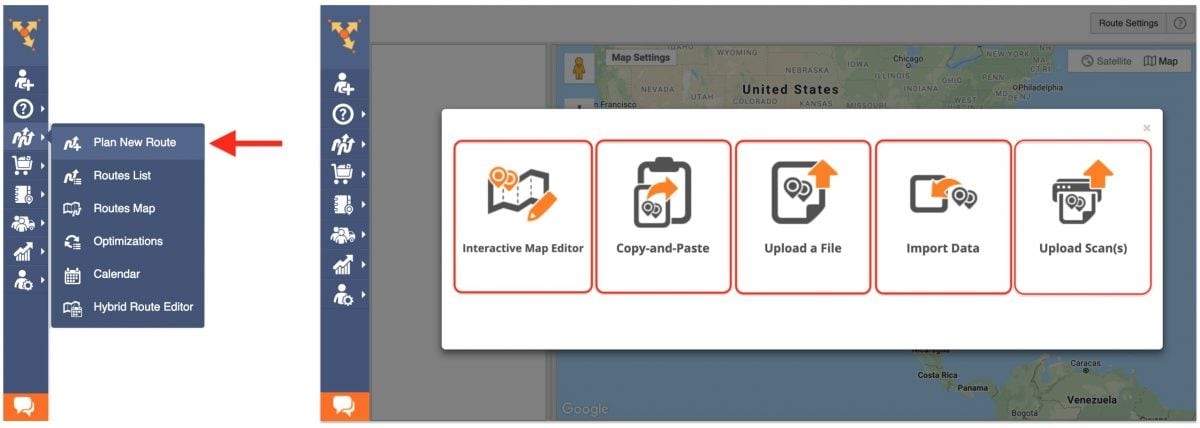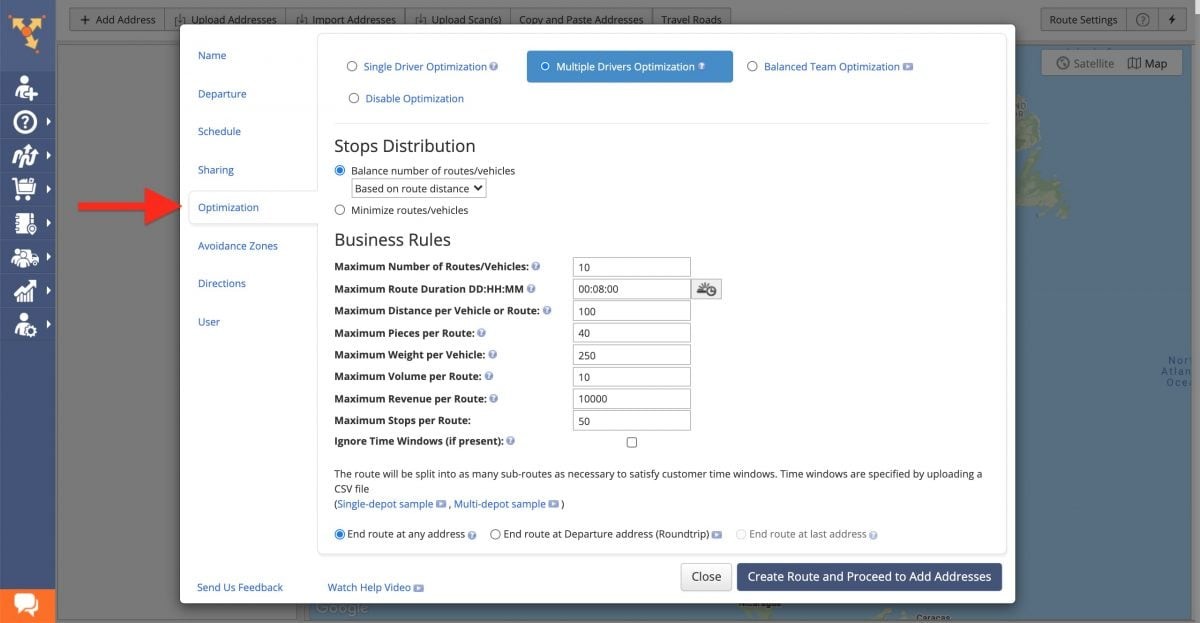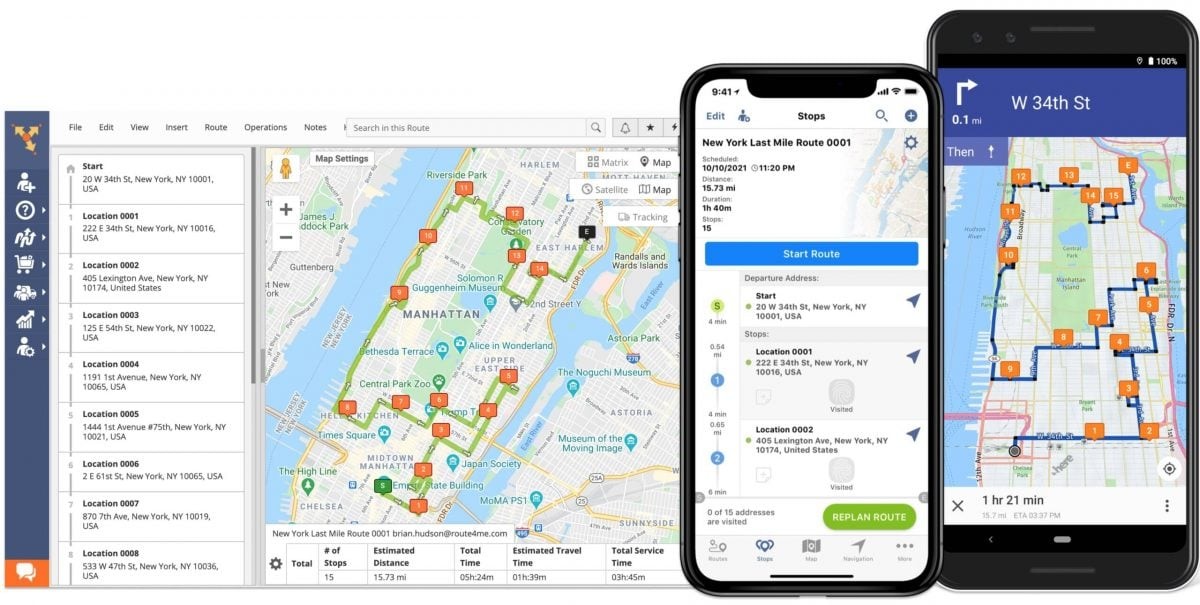Trucks are the lifeblood of the freight transport system, ensuring smooth supply chains and efficient delivery of goods to consumers. From essential consumer goods and fresh produce to bulky construction materials and hazardous cargo, trucks carry a diverse range of commodities, serving all needs of the economy. However, for smooth, cost-effective, and safe transportation, planning and optimizing truck routes is crucial. This article delves into the importance of optimizing shipping routes for trucks, especially in the context of today’s diverse goods.
The Importance of Truck Route Optimization for Freight Transport
In the freight transport industry, route optimization is more than just finding the shortest path from point A to point B. For trucks, especially those carrying cargo, effective route planning brings many practical benefits, directly impacting business efficiency and customer satisfaction.
1. Fuel Cost Savings: Fuel costs are consistently one of the largest expenses for transportation businesses. By using specialized truck routing software, businesses can find the shortest routes, avoid traffic congestion, minimize travel distance, and therefore, significantly reduce fuel consumption.
2. Reduced Delivery Time, Guaranteed Schedules: Delivery time is a key factor in freight transport, especially for fresh produce, frozen goods, or urgent deliveries. Optimized routes help trucks move quickly and on time, meeting delivery deadlines, enhancing reputation, and improving service quality.
3. Increased Transport Efficiency: When routes are optimized, trucks can complete more deliveries within the same timeframe. This increases the operating efficiency of the fleet, reduces operating costs per unit of goods, and maximizes profits.
4. Ensuring Safety for Goods and Drivers: Truck routing software not only helps find the shortest routes but can also select the safest routes, avoiding poor road conditions, truck-restricted roads, or high-risk accident areas. This helps protect goods from damage, minimizes risks for drivers, and ensures traffic safety.
5. Compliance with Transport Regulations and Road Restrictions: Trucks often have to comply with numerous traffic regulations and road restrictions such as weight limits, height restrictions, width restrictions, and prohibited routes. Truck routing software is designed to consider these factors, helping drivers avoid traffic violations, minimize the risk of fines, and ensure legal transport operations.
Common Types of Goods Using Trucks and Specific Shipping Requirements
Trucks are used to transport countless different types of goods, each with its own specific shipping requirements. Understanding these requirements is crucial for choosing the appropriate vehicle, route, and shipping method, ensuring goods are delivered safely and intact.
1. Dry Goods and Consumer Goods: (Clothing, household appliances, packaged food, groceries)
This is the most common group of goods, accounting for a large proportion of truck freight volume. Shipping requirements for dry and consumer goods usually focus on fast, on-time delivery to distribution centers, supermarkets, retail stores, or directly to consumers. Enclosed trucks and vans are commonly used to protect goods from weather and external impacts.
2. Fresh and Frozen Goods: (Vegetables, fruits, meat, fish, milk, dairy products)
Transporting fresh and frozen goods requires strict temperature control to ensure product quality and freshness. Specialized refrigerated trucks with modern cooling systems are indispensable. Shipping routes need to be optimized to minimize travel time, avoid congested areas, and ensure stable temperatures throughout the journey.
3. Bulky and Oversized Cargo: (Industrial machinery, construction equipment, building materials, steel structures)
Bulky and oversized goods have large dimensions and weights, exceeding normal standards. Transportation requires specialized trucks such as flatbed trucks, tractor-trailers, lowboy trailers, along with special safety measures to ensure goods are not damaged and do not pose a danger to traffic. Routes need to be carefully surveyed to avoid narrow roads, weak bridges, or height restrictions.
4. Hazardous Materials: (Chemicals, gasoline, gas, flammable materials, hazardous waste)
Transporting hazardous materials is a particularly sensitive area, requiring strict adherence to safety and fire prevention regulations. Trucks carrying hazardous materials must be specially designed, fully equipped with safety devices, and drivers must be professionally trained. Shipping routes must be pre-approved, usually avoiding densely populated residential areas, sensitive areas, and complying with transportation time regulations.
5. High-Value Goods: (Electronics, jewelry, luxury goods, artworks)
Transporting high-value goods requires absolute security and safety to prevent loss or theft. Security measures such as trucks with GPS tracking systems, security locks, route monitoring, and cargo insurance are often applied. Shipping routes need to be carefully planned, avoiding areas with security risks and ensuring close monitoring of the route.
 Uploading delivery addresses to truck routing software for commercial fleets
Uploading delivery addresses to truck routing software for commercial fleets
Specialized Truck Route Optimization Tools and Software
To effectively optimize truck routes, especially in the context of transporting diverse types of goods with different requirements, using specialized tools and software is essential.
Why Google Maps is Not Suitable for Trucks?
Although Google Maps is a popular map and navigation tool, it is not designed to meet the specific requirements of trucks and freight transport. Google Maps does not consider important factors such as:
- Weight, Height, and Width Restrictions: Google Maps does not warn about weak bridges, low tunnels, or roads prohibited for heavy trucks.
- Hazardous Materials: Google Maps does not have special routing features for trucks carrying hazardous materials, overlooking strict safety regulations.
- Road Type and Traffic Regulations: Google Maps may guide trucks onto prohibited roads, one-way streets, or truck-restricted areas.
Using Google Maps to plan truck routes is not only inefficient but can also be dangerous and lead to traffic violations.
Specialized Truck Routing Software: The Optimal Solution
Specialized truck routing software is specifically designed to address the above issues, providing comprehensive solutions for planning and optimizing freight transport routes. Key features of truck routing software include:
- Detailed Truck Profiles: Allows input of truck specifications such as vehicle type, dimensions, weight capacity, cargo type (including hazardous materials), helping the software calculate suitable routes.
- Specialized Road Network Database: Continuously updated with information on road restrictions, truck-prohibited roads, weak bridges, low tunnels, toll stations, helping to avoid unsuitable routes.
- Multi-Stop Route Optimization: Allows planning routes for multiple delivery points, optimizing the order of stops to minimize travel distance and time.
- Integrated Maps and GPS Navigation: Provides detailed maps, voice-guided directions, and real-time truck location tracking.
- Reporting and Analytics: Provides reports on distance, time, costs, transport performance, helping businesses evaluate and improve operations.
Route4Me: A Typical Truck Routing Software Solution
Route4Me is a prime example of specialized truck routing software, trusted by many transportation businesses worldwide. This software provides all the necessary features for planning, optimizing, and managing truck fleets, ensuring efficient and safe freight transport.
 Route optimization constraints in truck routing software for commercial routing
Route optimization constraints in truck routing software for commercial routing
Steps to Plan Effective Truck Routes with Specialized Software
To maximize the benefits of truck routing software, businesses need to follow a structured and scientific route planning process. Below are 8 basic steps to plan effective truck routes:
1. Build a Commercial Fleet Profile on Routing Software:
The first step is to create detailed profiles for each truck in your fleet on the software. Enter complete information about vehicle type, dimensions, weight capacity, hazardous material capability, and other technical specifications. This helps the software understand the characteristics of each truck and choose appropriate routes.
2. Input Delivery Addresses into the Routing Software:
Next, enter the list of delivery addresses and destinations into the software. You can enter manually, upload from an Excel file, or integrate with other management systems. Route4Me allows importing hundreds of thousands of addresses quickly and easily.
3. Choose Preferred Optimization Method:
Truck routing software offers various optimization methods, depending on your needs and goals. You can optimize by time, distance, cost, number of vehicles, driver skills, or a combination of factors. Choosing the appropriate optimization method will help you achieve maximum efficiency.
4. Select Route End Point:
Determine the endpoint for each route. You can choose to end at the starting point (round trip route), at the last stop, or at any convenient location. The software will automatically calculate the optimal endpoint based on your selection.
5. Add Optimization Constraints and Business Rules:
To customize routes to specific requirements, you can add optimization constraints and business rules such as priority delivery times, allowable delivery time windows, preferred road types (highways, toll-free roads), and other restrictions.
6. Optimize Truck Routes:
After completing the above steps, press the “Optimize” button, and the software will automatically calculate and generate the optimal route for your truck in seconds. You will receive a detailed route with the order of stops, distance, estimated time, and specific directions.
7. Dispatch Routes to Truck Drivers:
Assign the optimized routes to truck drivers through the software’s mobile app. The Route4Me driver mobile app allows drivers to receive routes, view directions, update delivery status, collect electronic signatures, and communicate with dispatchers.
8. Track Drivers During Route Navigation:
Use the GPS tracking feature in the software to monitor the location and progress of trucks in real-time. You can track on an online map, view travel history, and receive notifications about important events such as arrival at stops, departures, or delays.
 Dispatching truck routes to truckers on a truck routing software app
Dispatching truck routes to truckers on a truck routing software app
Conclusion
Optimizing truck routes is a key factor in improving freight transport efficiency, especially in the context of diverse goods and increasingly stringent shipping requirements. Using specialized truck routing software not only saves costs and time but also ensures safety, regulatory compliance, and improved service quality. Investing in route optimization technology is a wise decision, bringing long-term benefits to transportation businesses and contributing to the sustainable development of the logistics industry in Vietnam.
